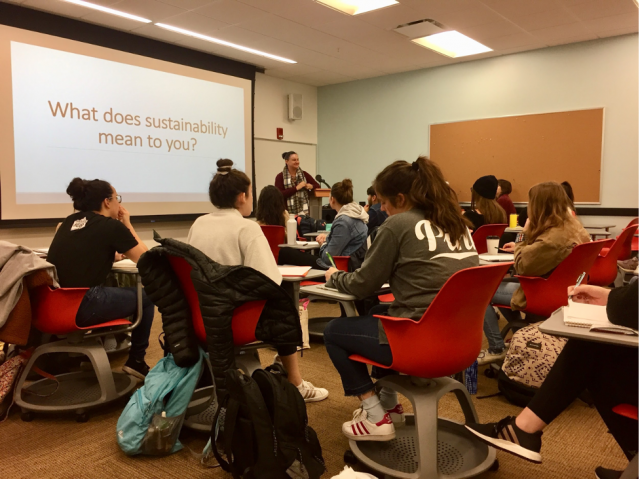Students Reimagine Campus Spaces Using Sustainable Design Principles

The Sustainable Design course challenged students to redesign spaces across the FSU campus as sustainably as possible.
In collaboration with Facilities Design & Construction, undergraduate students in the Spring 2020 IND 3627 Sustainable Design course applied principles and products of sustainable design to reimagine an existing space on campus.
Led by Professor Meghan Mick, Adjunct Instructor for the Interior Design Department, students looked at ways their selected space could be enhanced to add to its overall sustainability, taking into consideration social, environmental, and economic impacts. Working in teams, each group approached their campus location in a different way to achieve a more sustainable space.
“It’s becoming mainstream to be green and sustainable,” said Mick. “In general, the shift people are making is to be more environmentally friendly. It’s important that students have a good handle on sustainable products as they enter the interior design field.”
Students reimagined Keen Room 503, Keen Room 504, the Askew Student Life Center Room 001, and the Fine Arts ticket window over the course of the semester. The proposed solutions adhered to FSU design guidelines and included an educational component that informs users about the sustainable methods or products used in the space. Furthermore, the solutions were contextually appropriate, considerate of the building in which they were located and the diverse types of people utilizing the space.
The students’ final deliverables included a presentation board with images and key components of the space, a written explanation of the design, and a 15-20 minute presentation on the sustainable methods and products used in the design and why they were selected.
“I learned that sustainable products are easier to find than I originally thought,” said one participating student.
Project partner Elizabeth Swiman from Sustainable Campus noted that it was interesting to see different groups tackle the same spaces in many different ways. Swiman also appreciated that the groups focused on social aspects of sustainability such as health and wellbeing. Students took a more holistic approach to design by incorporating ergonomic features and demonstrated collaboration and creativity.
“Overall, I’m very excited by what the students have created,” said Swiman. “I’m so thankful we got to participate in the opportunity for students to learn what sustainable design looks like in a University setting.”
To learn more about the Campus as a Living Labs program, visit sustainablecampus.fsu.edu/academics-research/campus-living-laboratory.

